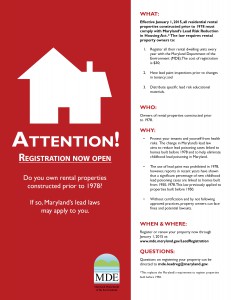Maryland lead program opens registration for rental properties built before 1978
Media Contacts:
Samantha Kappalman
samantha.kappalman@maryland.gov
Jay Apperson
jay.apperson@maryland.gov
410-537-3003
FOR IMMEDIATE RELEASE:
 Maryland lead program opens registration for rental properties built before 1978
Maryland lead program opens registration for rental properties built before 1978
Current law requires rental properties built before 1950 to be registered in State program that protects children from lead paint poisoning; change in law now requires newer rental properties to be registered by January
BALTIMORE, MD (July 1, 2014) – Moving to protect more children from the health risks associated with lead paint poisoning, the Maryland Department of the Environment (MDE) today began accepting registration applications for rental properties built prior to 1978.
Maryland’s existing lead law requires owners of rental properties built before 1950 to register their properties with MDE and comply with a lead paint risk reduction standard. Because a significant percentage of new childhood lead poisoning cases are linked to homes built after 1949, the Maryland General Assembly passed a bill in 2012 that Governor Martin O’Malley signed into law, House Bill 644, that expands the universe of properties covered under the law to include rental properties built before 1978, when the use of lead paint was prohibited nationally. That change is effective January 1, 2015.
Owners of the later-built properties affected by the change in law can now register these properties with MDE online at www.mde.maryland.gov/LeadRegistration.
MORE INFORMATION:
Childhood lead poisoning is a completely preventable disease.
The number of childhood lead poisoning cases has decreased by 98 percent since the enactment of Maryland’s landmark 1994 Lead Risk Reduction in Housing Act, but a significant number of new lead poisoning cases in recent years have been linked to pre-1978 homes that had not been covered by the law.
House Bill 644 of 2012 also allows MDE to seek delegation from the U.S. Environmental Protection Agency to administer a current federal rule that regulates renovations, repairs and painting in homes that were built before 1978, regardless of whether they are rental units or owner-occupied, and in pre-1978 childcare facilities with young children. The rule requires contractors who do work on these properties to receive training and use lead-safe work practices. Maryland regulations to allow MDE to administer the federal rule are under development.
CORE FACTS:
- MDE’s Lead Poisoning Prevention Program serves as the coordinating agency of statewide efforts to eliminate childhood lead poisoning.
- Under the Maryland lead law, MDE assures compliance with mandatory requirements for lead risk reduction in rental units built before 1950; maintains a statewide listing of registered and inspected units; and provides blood lead surveillance through a registry of test results of all children tested in Maryland. The Lead Program also: oversees case management follow-up by local health departments for children with elevated blood lead levels; certifies and enforces performance standards for inspectors and contractors conducting lead hazard reduction; and performs environmental investigations of lead poisoned children. The Lead Program provides oversight for community education to parents, tenants, rental property owners, home owners and health care providers to enhance their roles in lead poisoning prevention.
- Exposure to lead is the most significant and widespread environmental hazard for children in Maryland. Children are at the greatest risk from birth to age 6, while their neurological systems are developing. Exposure to lead can cause long-term neurological damage that may be associated with learning and behavioral problems and with decreased intelligence.
- In Maryland counties outside of Baltimore City, nearly half of confirmed cases of an initial report of lead poisoning in the past two years for which data has been analyzed, involved children living in post-1949 rental housing.
- A 2011 study found that properties built between 1950 and 1960 have an 80 percent likelihood of containing lead-based paint. This likelihood declines rapidly for properties built after 1960 until use of lead paint was prohibited in 1978.
- The number of properties affected by the change in the law (rental properties built from 1950 up to 1978) is estimated at more than 250,000.
- The registration fee is $30 per year for rental unit.
- Failure to register, certify or follow approved lead-safe work practices may subject property owners to thousands of dollars in fines and potential lawsuits.
QUOTES:
“The Maryland Department of the Environment wants everyone to know about the change in the law that requires owners of newer rental properties to register them with our lead program and comply with the law’s requirements. Registering these properties helps protect your tenants and your families from the health risks associated with lead paint poisoning. It’s the right thing to do.”
–Robert M. Summers, Secretary, Maryland Department of the Environment
“Working with our partners, including Baltimore City and the Green & Healthy Homes Initiative, Maryland has made significant gains to protect our children, particularly those who live in older rental housing. But a significant number of lead poisoning cases in Maryland are linked to newer rental housing. The change in Maryland’s lead law will allow us to prevent more children from suffering the effects of lead poisoning. We cannot, and will not, let up in our work to eliminate childhood lead poisoning in our state.”
–Robert M. Summers, Secretary, Maryland Department of the Environment
ADDITIONAL INFORMATION:
Online Lead Rental Registration
MDE Lead Poisoning Prevention Program
Maryland Childhood Lead Registry Annual Surveillance Reports
EPA’s Renovation Repair and Painting Program
MISSION:
Our mission is to protect and restore the quality of Maryland’s air, water and land resources, while fostering smart growth, a thriving and sustainable economy and healthy communities.
###
